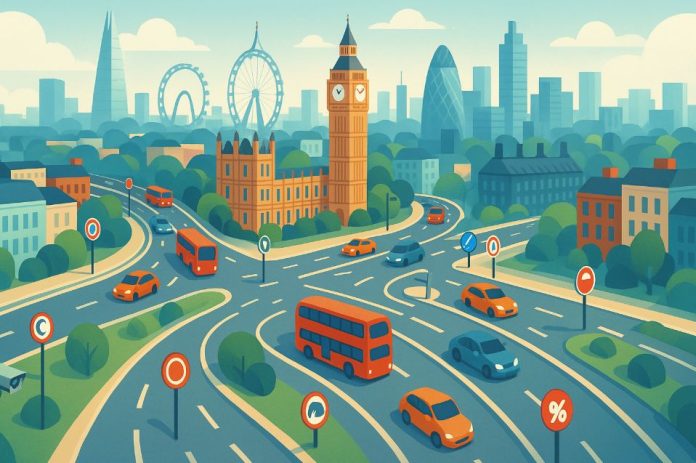Table of Contents
The London Congestion Charge has become a fundamental part of managing the city’s traffic and environmental policies.
Whether you’re a London resident or a visitor planning to drive into the capital, understanding where the congestion charge zone starts and ends is vital to avoiding unexpected fines and ensuring a smoother travel experience.
This guide explores the boundaries of the congestion zone, its operating times, payment process, and what sets it apart from other schemes like the ULEZ.
What is the London Congestion Charge and Why Was It Introduced?
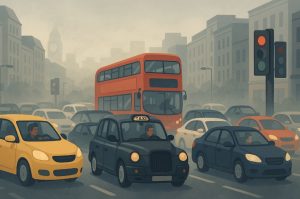
The London Congestion Charge was introduced in 2003 by Transport for London (TfL) to address growing concerns around traffic congestion and air pollution in the heart of the city.
As Central London faced increasing vehicle flow and deteriorating air quality, the congestion charge was designed as a deterrent to non-essential car travel, encouraging drivers to consider alternatives such as public transport, walking, or cycling.
This initiative has since become a cornerstone of London’s broader environmental and traffic management strategy.
Where Exactly Does the Congestion Charge Zone Begin and End?
The Congestion Charge Zone, often abbreviated as CCZ, encompasses a large section of Central London.
It includes well-known areas such as Westminster, the City of London, Holborn, Mayfair, and parts of Southwark and Lambeth. The borders are not defined by a perfect geometric shape but follow a combination of borough boundaries and major roads.
To the north, the zone typically ends around Euston Road, while the southern boundary lies near Vauxhall Bridge Road. To the east, areas around Tower Bridge Road mark the limit, and the western edge runs along Park Lane and Edgware Road.
These streets serve as critical transition points where entering traffic begins to be monitored for congestion charge enforcement.
Navigating these boundary lines can be challenging for newcomers, but TfL provides an up-to-date and interactive zone map that pinpoints where the charge applies and where it does not.
What Does the London Congestion Charge Zone Map Look Like?
The official congestion charge map provided by TfL offers an accurate and interactive way to identify whether a particular street falls inside or outside the charging area.
Key zones and boundary streets are clearly marked, and users can search by postcode or street name to see if a journey is subject to the fee.
For regular drivers, this map is indispensable. It helps plan routes that avoid charges by sticking to outer boundary roads while highlighting entry and exit points that are camera-monitored.
TfL’s map is also updated regularly to reflect any policy changes, road closures, or expansions, making it the most reliable source for navigation and compliance.
When Do Congestion Charges Apply in London?
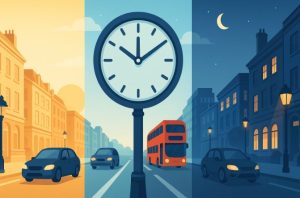
The congestion charge does not apply 24/7, but there are specific hours during which vehicles entering the zone are required to pay.
On weekdays, the charge is enforced from 7:00 am to 6:00 pm, and during weekends, from 12:00 pm to 6:00 pm. The only times when the charge is entirely suspended are on Christmas Day and during the New Year’s holiday period.
This schedule was updated in recent years to increase coverage and reduce congestion during busy weekend afternoons.
Therefore, it’s essential to be aware of these timings even if you’re visiting on a Saturday or Sunday.
How Much is the Daily Congestion Charge in London?
As of now, the standard fee for entering the congestion zone is £15 per day if paid on the day of travel or in advance. However, if payment is delayed, the charge increases to £17.50 if settled by midnight on the third day after travel.
To make things easier for frequent drivers, TfL offers an Auto Pay system, which reduces the daily charge and helps avoid penalty notices by automatically charging registered vehicles.
The payment process is straightforward, and options are available online through the TfL website, the official mobile app, or by setting up an Auto Pay account.
What Happens If You Don’t Pay the Congestion Charge?
Failing to pay the congestion charge can result in a Penalty Charge Notice (PCN) being issued to the vehicle owner. The penalty is currently set at £160, which is reduced to £80 if paid within 14 days.
Enforcement is carried out using a network of Automatic Number Plate Recognition (ANPR) cameras placed throughout the zone’s entry and exit points.
These cameras capture the registration number of every vehicle entering the zone, automatically checking if payment has been made.
It’s worth noting that once a PCN is issued, you have the right to appeal it if you believe it was sent in error, although valid reasons and supporting evidence will be required.
How is the Congestion Charge Different from the ULEZ Zone?
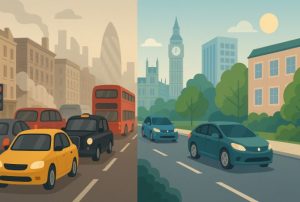
Although both the Congestion Charge and ULEZ (Ultra Low Emission Zone) serve environmental and traffic reduction purposes, they are fundamentally different schemes.
The Congestion Charge applies to nearly all vehicles regardless of emission level and is primarily aimed at reducing traffic volumes. In contrast, ULEZ targets only vehicles that fail to meet specific emissions standards, such as older diesel and petrol cars.
ULEZ covers a far wider area than the congestion zone, stretching across almost all of Greater London. However, in many parts of Central London, the two zones overlap. This means that some drivers may need to pay both fees on the same day depending on their vehicle type and destination.
Which Vehicles Are Exempt from the Congestion Charge?
Not all vehicles entering the zone are subject to the congestion charge. For instance, fully electric vehicles are currently exempt from the fee, provided they are registered with TfL.
Other exemptions apply to emergency service vehicles, motorcycles, mopeds, and certain disabled drivers with valid Blue Badges.
Residents who live within the congestion charge zone can apply for a 90% discount, which helps to offset the cost of living in a high-traffic area. Taxis and some private hire vehicles may also qualify for exemptions or discounts depending on their status and emissions compliance.
How Can You Pay the London Congestion Charge Online?
Paying the congestion charge is a relatively straightforward process. Most drivers choose to pay online via the Transport for London website, where you can enter your vehicle registration number, choose the date of travel, and pay using a credit or debit card.
There’s also a mobile app called TfL Pay to Drive in London that simplifies this process for users on the go.
For those who travel into the zone frequently, the Auto Pay system is highly recommended. Once registered, it tracks your vehicle and deducts the correct amount automatically, often at a discounted rate.
This system is particularly useful for business owners and delivery drivers who operate within Central London regularly.
What Streets Mark the Border of the Congestion Charge Zone?
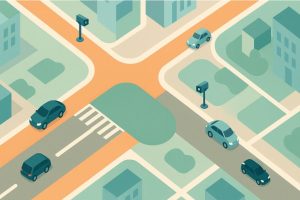
Identifying the exact streets that form the zone’s boundary is important for avoiding unintentional charges. Streets such as Euston Road to the north, Park Lane to the west, Tower Bridge Road to the east, and Vauxhall Bridge Road to the south are considered main perimeter roads.
In most cases, staying on these roads keeps you outside the zone, but turning into adjacent side streets often results in entering the charge area.
Street signs and road markings clearly indicate when you’re about to cross into the congestion zone. These signs display a red “C” symbol and often include operational hours for clarity.
Are There Alternatives to Driving in the Congestion Zone?
London offers a vast network of public transport options that make it easy to avoid driving altogether. The London Underground, Overground, and National Rail services provide excellent coverage across the city. Buses operate around the clock, and many routes serve Central London directly.
For shorter trips, the city’s cycling infrastructure and the Santander Cycle hire scheme provide a healthy and cost-effective alternative.
Walking is also a viable option, with well-maintained pedestrian paths and signage throughout the centre.
For those who need to drive, Park and Ride facilities located outside the charge zone allow you to park your vehicle and switch to public transport for the remainder of your journey.
What’s Next for the London Congestion Charging Scheme?
Transport for London regularly reviews and updates the congestion charge system to align with broader environmental and infrastructure goals. While there has been speculation about expanding the zone or implementing variable pricing based on traffic levels, no definitive changes have been announced as of the latest update.
However, with growing emphasis on reducing emissions and encouraging sustainable travel, it is likely that the scheme will continue to evolve. Future developments may include integration with new low-emission initiatives or technological enhancements to improve user experience and enforcement accuracy.
Conclusion
Yes, knowing exactly where the London Congestion Charge zone starts and ends is essential for any driver entering Central London.
Being informed not only helps avoid penalties but also supports better route planning and contributes to the city’s efforts in reducing congestion and pollution.
Whether you’re a daily commuter, a business owner, or a tourist with a hire car, staying updated with the latest zone boundaries and charges is a smart and responsible move.
FAQs about London’s Congestion Charges
Do electric cars need to pay the congestion charge?
Electric cars are currently exempt, but drivers must register their vehicle with TfL to qualify for the exemption.
Are motorcycles included in the congestion charge?
No, motorcycles and mopeds are exempt and can travel freely within the zone without paying the charge.
Can I still pay if I forget on the day?
Yes, you can pay up to midnight on the third day after travel, although the cost increases slightly.
Do I pay both ULEZ and congestion charge?
It depends on your vehicle and destination. If your vehicle doesn’t meet ULEZ standards and you enter the Congestion Zone, you may need to pay both.
Is there a discount for people living inside the congestion zone?
Yes, registered residents can apply for a 90% discount on the daily charge.
How can I check if my journey goes into the zone?
Use TfL’s interactive congestion charge map online to input your route or postcode.
What happens if I receive a penalty notice in error?
You can appeal a PCN by providing supporting evidence through the TfL website.

